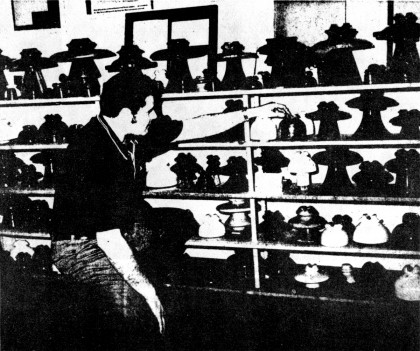Insulator Collector of the Month
Reprinted from "INSULATORS - Crown Jewels of the Wire", July 1978, page 36
Paul Mohrs reaches for one of the many porcelain insulators in his Chesterton
hone. Besides collecting the electrical insulators, Mohrs has researched their
history and become editor of a bimonthly publication about insulator
collections. (News-Dispatch photo by Dennis Gruse)

Memento Turns Into Collection
By DENNIS GRUSE
News-Dispatch staff writer
CHESTERTON, Ind. -- One day as Paul Mohrs and a friend walked along ConRail
tracks in Pine Twp. Paul found a large glass object with some threading inside
the open end.
Paul picked up the object, examined it closely and then decided it would be a
worthy memento of the day's activities. He took it home that summer day in 1969
and placed it on a shelf. At the time he never realized this glass insulator
would open a number of doors into a variety of new activities for him.
Paul now has several hundred insulators among his collection. About 55
percent of them are porcelain. The rest are glass insulators.
Several rooms in Paul's apartment here proudly display. his insulator
collection. He readily picks up any insulator and talks about the role it played
in this nation's industrial development.
A graduate of Indiana State University in Terre Haute, Paul now works at
Bethlehem Steel's Burns Harbor plant. A variety of activities keep this
26-year-old bachelor busy.
Paul grew up in Michigan City. He moved here last year to be closer to
work.
Since Paul picked up his first electrical insulator, he has had as many as
1,500 insulators among his collection. Most of the duplicates have been traded
in recent years with other collectors across the nation to obtain other
treasured insulators.
Paul has done much more than just collect the insulators. He also researches
their history. This research has opened a whole new area of information to him
about the nation's industrial revolution and developments since then.
The first glass insulators were produced for the early telegraph. In the
1840s, insulators were placed on pegs with caulking and sometimes covered with
boxes to protect them from curious Indians who would. use the glass for
arrow-heads. The first insulator Paul found along the ConRail tracks dated back
to 1860.
"Between 1900 and 1970, 17 companies were producing glass
insulators," Paul said. "None are produced now. Only porcelain and
plastic insulators are manufactured now."
These insulators help decrease the loss in electrical currents being
transmitted via electrical lines. They especially help reduce voltage losses
that can be caused by moisture problems.
Numerous collectors like Paul are making sure the glass insulators don't
disappear entirely from the scene. Most glass insulators in Paul's collection
are green or light blue-colored. That coloring comes from impurities present in
the glass-making materials.
The glass insulators are about 4 inches high and about 3-1/2 inches wide. In
contrast, the porcelain insulators in Paul's collection vary differently. While
some are only 3-1/2 inches wide and 2-1/2 inches high, others are as wide as 16
or more inches and go up to 2 feet high.
There presently are four major domestic manufacturers of porcelain
insulators. Only one major manufacturer produces plastic insulators.
Some of Paul's insulators were found along South Shore Railroad tracks. This
has given Paul another added interest -- interurban commuter lines. This
interest presently focuses on the South Shore Railroad's commuter line.
Paul has various memorabilia from the South Shore on display in his
three-room apartment. Some of it relates to recent attempts to preserve the
electric line's passenger service. Paul hopes these efforts succeed.
As Paul searched out other insulator collectors, he became acquainted with
publishers of information about insulators and their collectors. Once again, one
thing led to another.
Paul now also serves as editor, writer and illustrator for The Ohio Valley
Insulator Club News. Published bi-monthly, this newsletter now has the
second largest circulation among insulator collectors.
Paul's activity with this newsletter started another new interest for him --
journalism. He now reports on Chesterton park board meetings and park department
activities and authors feature-type articles for The News-Dispatch.
One little glass insulator found along a railroad track has made a
significant impact on Paul's life. It has established new interests in several
fields. As Paul continues reporting for The News-Dispatch, he'll probably
find other interesting avenues also worth wandering on down into other new
discoveries.
- - - - - - - - -
(The above article was reproduced from News-Dispatch, Michigan City,
Ind., Tuesday, January 10, 1978, issue.)
| 